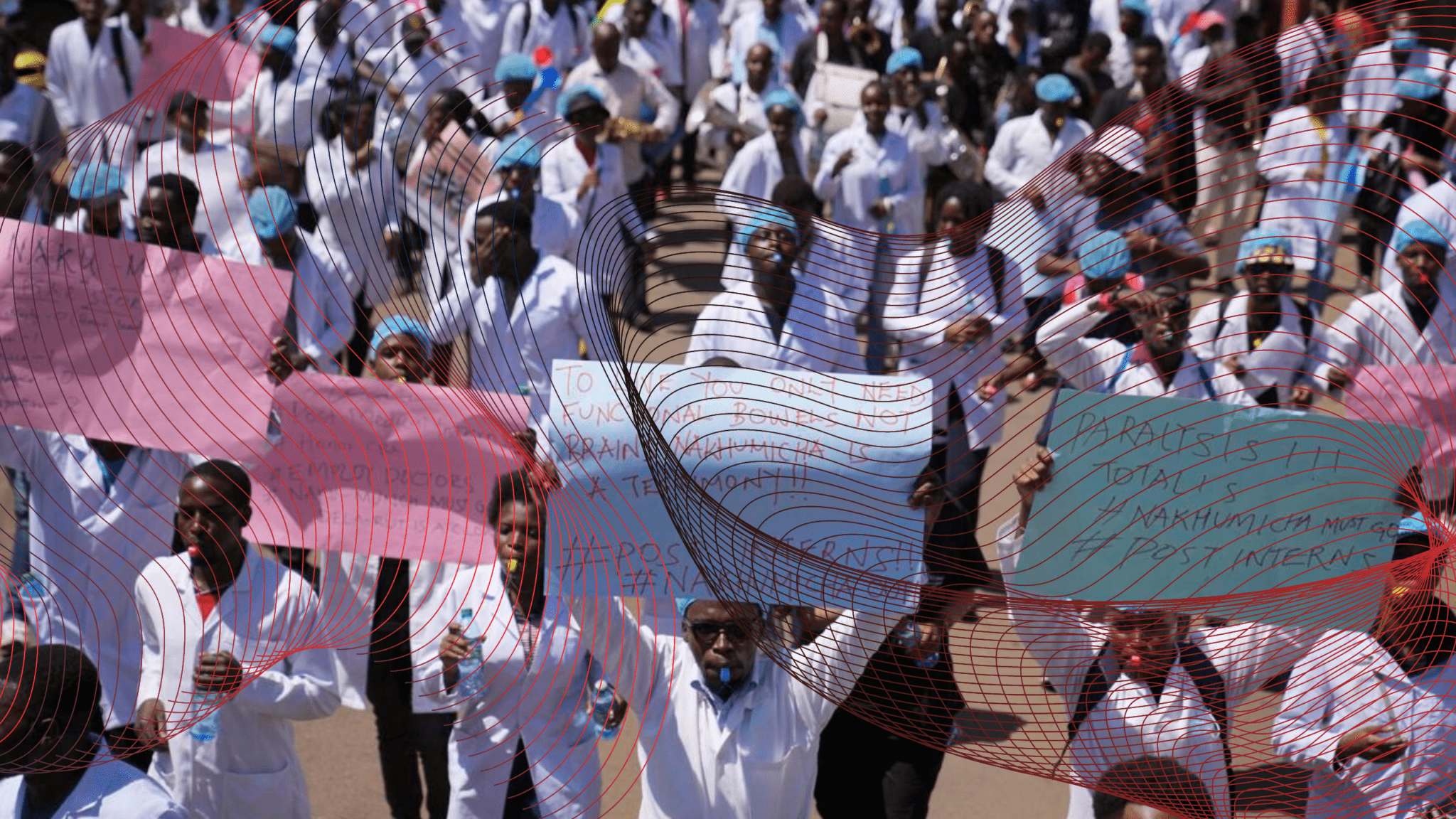DEBT MANAGEMENT INSTRUMENTS TO INCREASE LIQUIDITY AND END STRIKES IN KENYA
Articles & Insights
April 05, 2024

By
Muliru Yoni
Amidst the ongoing health crisis intensified by striking doctors, Kenya finds itself grappling with the dire consequences of a failing health sector, compounded by soaring living costs and associated challenges. These issues not only illuminate the harsh realities plaguing the Kenyan state but also serve as a stark warning of potential future crises if decisive action is not taken. With the current trajectory, other critical sectors such as education, security, and energy could soon face similar disruptions. In this precarious state, the question arises: Can the Government of Kenya (GoK) leverage internal debt management instruments to swiftly resolve the ongoing strike and prevent further disruptions, especially considering other pending collective bargaining agreements that remain unfulfilled?
Economic and public policy theories offer valuable insights into how governments can effectively manage their debts. One prominent theory is the Financial Instruments Theory, which suggests that governments can utilize a range of financial instruments such as bonds, commercial papers, and treasury bills (T-bills) to raise capital and address financial obligations. These instruments provide governments with the flexibility to access diverse funding sources, manage liquidity, and meet both short-term and long-term financial needs. Implementing such strategies aligns with sound financial management practices and enables governments to navigate financial challenges more effectively.
Moreover, these strategies also uphold the principle of inter-generational equity by ensuring that current financial needs are met without burdening future generations with excessive debt. Furthermore, employing these financial tools can also leverage the Signaling Theory outcomes for better results. By effectively using such instruments and guaranteeing their redemption, the GoK (for example), can send strong signals of its commitment to fulfilling its financial obligations. This builds trust with striking workers and creates incentives for accepting debt settlement options and agreements to avoid strikes.
Strikes signify a breakdown in negotiations, and the use of debt management instruments can be viewed as an innovative approach to bridging the gap between worker demands and government constraints, facilitating resolution within a collective bargaining framework. For instance, in the United States, during periods of financial turmoil or government shutdowns, the government resorted to using treasury bonds, bills, and notes as financial instruments to manage debt obligations, ensure liquidity, and tackle fiscal challenges effectively. Similarly, Argentina’s experience illustrates another compelling example where, in response to economic crises and labor disputes stemming from sovereign debt issues impacting public sector worker pensions, the government issued sovereign bonds, commercial papers, and T-bills to secure funds for debt settlement, sustain government operations, and restore confidence in financial markets. Notably, the government later issued new bonds at reduced values to partly compensate affected workers.
Likewise, the Singaporean government regularly employed government bonds, treasury bills, and securities within its debt management and fiscal policy frameworks. In Japan, the government has often utilized bonds and treasury bills to finance public expenditures, manage debt levels, and address economic downturns. During periods of labor unrest, Japan (for example), leveraged these financial tools as part of broader economic strategies to resolve labor-related disputes and uphold financial stability. Similarly, the German government has previously employed commercial papers and short-term securities to swiftly secure funds for debt settlements and bolster public services. In a comparable context within Europe, Greece’s experience demonstrates negotiations of austerity measures with striking public sector workers, to include extended loan maturities and issuing new bonds at lower interest rates in exchange for wage reductions. These examples highlight the diverse ways in which governments worldwide have utilized debt management instruments to navigate labor disputes, manage financial challenges, and foster economic stability. Why is the GoK not considering these options?
I suggest that the Government of Kenya (GoK) begins by conducting a thorough assessment of its financial status, including debt capacity and credit rating, in relation to outstanding workers’ debts and collective bargaining agreements. This assessment will determine whether issuing government bonds to settle the debts of striking workers is feasible without jeopardizing fiscal stability. Additionally, considering the prevalence of corruption, the process should adhere to regulatory frameworks governing bond issuance. Collaboration with stakeholders such as financial institutions, financial regulators, legal experts, and relevant government agencies is essential to streamline the process and mitigate legal risks effectively. This process should be led by a party outside government to improve trust.
Following the assessment, the GoK can leverage this newfound information to renegotiate debt settlement terms and reach a mutually acceptable agreement with striking workers. The negotiation process should be flexible and well-defined, covering aspects such as debt amounts, repayment schedules, applicable interest rates, and mechanisms for bond redemption. Addressing key demands related to salary arrears, working conditions, benefits, and future commitments is crucial during this negotiation phase.
Next, the GoK can prepare and issue Government Debt Management Options tailored to settle outstanding debts owed to current striking workers and others, as per registered collective bargaining agreements in the country. Collaboration with financial institutions, bond underwriters, and investment banks will facilitate the bond issuance process, ensuring market liquidity. These bonds, being long-term debt instruments with fixed interest rates, will provide workers with a reliable investment opportunity backed by the government’s creditworthiness. The issuance will be structured to cover the outstanding debts while showcasing the government’s commitment to fulfilling financial obligations. Moreover, considering the attractiveness of these bonds, the GoK may offer guarantees on their full redemption at maturity and provide tax breaks on interest earned from holding the bonds or papers. These incentives can further encourage striking workers to accept this debt settlement method, alleviate concerns about defaults, and enhance the bonds’ appeal.
Lastly, throughout the resolution process, clear and consistent communication with the public, investors (including workers), and stakeholders is vital to building confidence in the government’s financial stability and commitment to resolving worker strikes. Messaging regarding the issuance of bonds, papers, and T-bills as part of the debt settlement strategy is crucial in reassuring creditors, investors, and the public about the government’s financial soundness and its dedication to honoring obligations. This strategy also presents an opportunity for the government to communicate its commitment to future investments in key sectors such as healthcare, education, infrastructure, and social welfare.
The process should prioritize comprehensive stakeholder engagement, including labor unions, industry associations, investors, and the public, to secure broad support for the government’s bond issuance strategy. This engagement should encompass outreach campaigns, public consultations, and stakeholder meetings aimed at clarifying the advantages of utilizing bonds for debt settlement and showcasing the government’s commitment to future investments. Maintaining transparency and accountability throughout the process is paramount. Additionally, a robust monitoring and evaluation framework must be established to assess the impact of the strategy on debt settlement, investor confidence, and future government investments. This framework should evaluate key performance indicators such as yields, debt-to-GDP ratio, credit ratings, and public perception. These evaluations will enable informed decision-making for future financial planning and ensure the effectiveness of the strategy in achieving its objectives.
I believe that these approaches offer several significant advantages that are crucial for effectively resolving labor disputes, securing workers’ debts, and ensuring the stability of essential services in a country. Firstly, issuing bonds allows the GoK to spread out the debt repayment burden over a longer period, easing the strain on the national budget. It helps in managing cash flow more effectively and prevents financial constraints that could impede critical expenditures. Secondly, offering this strategy provides all workers with immediate access to a portion of their owed funds, addressing their short-term financial needs. This infusion of liquidity is especially vital for government professionals facing financial challenges due to delayed payments or salary arrears. Moreover, tradable bonds and commercial papers offer striking workers liquidity options, enabling them to sell their holdings if necessary. This market-based approach enhances flexibility and transparency in financial transactions, contributing to a more robust financial ecosystem.
Resolving labor disputes and securing workers’ debts through the issuance of debt instruments contribute to maintaining essential services’ continuity, such as healthcare. This benefits both patients and workers by ensuring healthcare access, quality of care, and patient safety. Scofield Associates is available to provide detailed guidance and manage the process of implementing this proposal. We believe that these benefits justify the strategic use of debt instruments in resolving labor-related issues and maintaining economic stability, particularly during periods of financial strain or economic downturns when immediate debt repayment may not be feasible.
He is a researcher, program manager and M&E specialist in the Horn of Africa. His research focuses on the prevention and countering of violent extremism (P/CVE), border security, rehabilitation, and reintegration (DDR), migration, and climate change.
Muliru Yoni
Director - Scofield Associates

